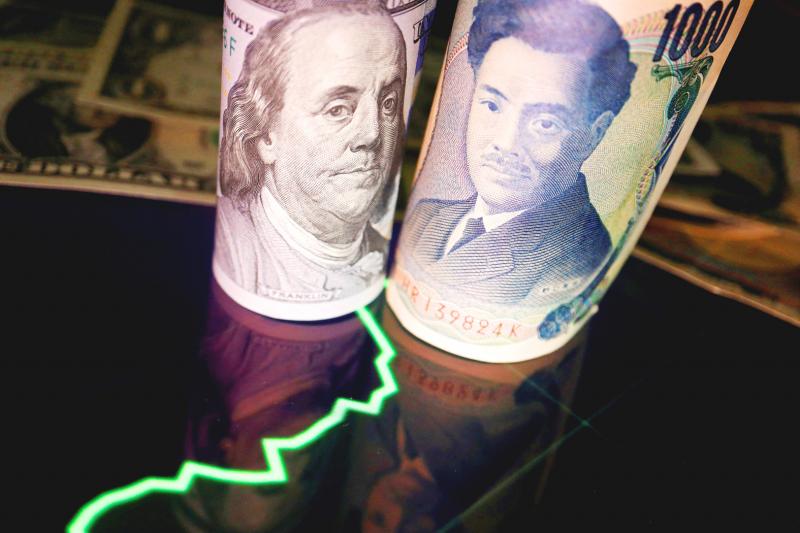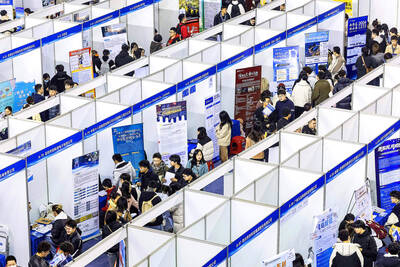The US dollar on Friday rallied across the board, notching its biggest daily percentage gain since the middle of June against the yen, after a stronger-than-expected US payrolls report suggested the US Federal Reserve might need to continue aggressively raising interest rates in the near term.
The US dollar index, which measures the greenback against a basket of currencies, sharply extended gains following the report, which showed nonfarm payrolls increased by 528,000 jobs last month, the largest gain since February. That was well above economists’ expectations.
The dollar index, which remains below its high from the middle of last month, closed up 0.84 percent at 106.58. It was up about 0.2 percent just before the release of the US Department of Labor’s employment report. The index was up about 0.64 percent for the week.

Photo: Reuters
“This is a much stronger report than was expected... What it means is the Fed cannot pivot at this point. The Federal Reserve has to continue to hike rates. The folks who are saying let’s take it more slowly are being shoved aside here with this report,” said Axel Merk, president and chief investment officer at Merk Investments LLC in Palo Alto, California.
“The dollar is stronger against almost everything. The US is performing when the general mood is that the world is slowing down,” he said.
The US dollar fell against the New Taiwan dollar, shedding NT$0.044 to close at NT$29.950, down 0.04 percent from NT$29.938 a week earlier.
Against the yen, the dollar was last up 1.5 percent at ¥134.99. For the week, the dollar was up 1.3 percent against the yen.
The Fed last week raised its policy rate by three-quarters of a percentage point. The US central bank has raised that rate by 225 basis points since March, but investors had been assessing whether the Fed might be less aggressive in hiking rates in the future.
The dollar index is up more than 11 percent for the year so far amid the outlook for higher rates. Sterling was down 0.8 percent against the dollar at US$1.2066, a day after the Bank of England raised rates by the most in 27 years to fight surging inflation and warned that a long recession would begin in the fourth quarter of this year.
The euro was down 0.7 percent against the greenback at US$1.0178.
Additional reporting by staff writer, with CNA

Stephen Garrett, a 27-year-old graduate student, always thought he would study in China, but first the country’s restrictive COVID-19 policies made it nearly impossible and now he has other concerns. The cost is one deterrent, but Garrett is more worried about restrictions on academic freedom and the personal risk of being stranded in China. He is not alone. Only about 700 American students are studying at Chinese universities, down from a peak of nearly 25,000 a decade ago, while there are nearly 300,000 Chinese students at US schools. Some young Americans are discouraged from investing their time in China by what they see

MAJOR DROP: CEO Tim Cook, who is visiting Hanoi, pledged the firm was committed to Vietnam after its smartphone shipments declined 9.6% annually in the first quarter Apple Inc yesterday said it would increase spending on suppliers in Vietnam, a key production hub, as CEO Tim Cook arrived in the country for a two-day visit. The iPhone maker announced the news in a statement on its Web site, but gave no details of how much it would spend or where the money would go. Cook is expected to meet programmers, content creators and students during his visit, online newspaper VnExpress reported. The visit comes as US President Joe Biden’s administration seeks to ramp up Vietnam’s role in the global tech supply chain to reduce the US’ dependence on China. Images on

New apartments in Taiwan’s major cities are getting smaller, while old apartments are increasingly occupied by older people, many of whom live alone, government data showed. The phenomenon has to do with sharpening unaffordable property prices and an aging population, property brokers said. Apartments with one bedroom that are two years old or older have gained a noticeable presence in the nation’s six special municipalities as well as Hsinchu county and city in the past five years, Evertrust Rehouse Co (永慶房產集團) found, citing data from the government’s real-price transaction platform. In Taipei, apartments with one bedroom accounted for 19 percent of deals last

Taiwan Transport and Storage Corp (TTS, 台灣通運倉儲) yesterday unveiled its first electric tractor unit — manufactured by Volvo Trucks — in a ceremony in Taipei, and said the unit would soon be used to transport cement produced by Taiwan Cement Corp (TCC, 台灣水泥). Both TTS and TCC belong to TCC International Holdings Ltd (台泥國際集團). With the electric tractor unit, the Taipei-based cement firm would become the first in Taiwan to use electric vehicles to transport construction materials. TTS chairman Koo Kung-yi (辜公怡), Volvo Trucks vice president of sales and marketing Johan Selven, TCC president Roman Cheng (程耀輝) and Taikoo Motors Group